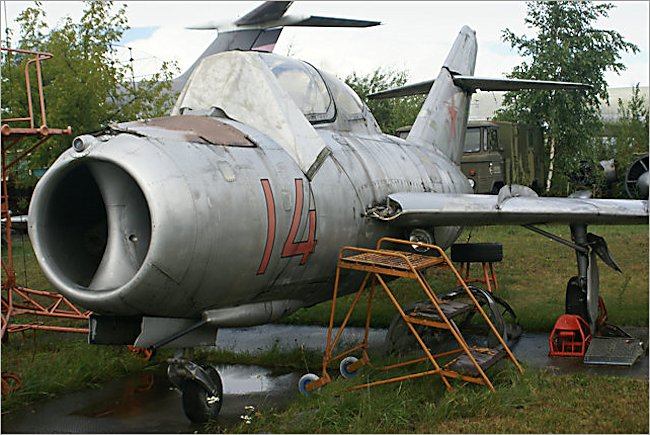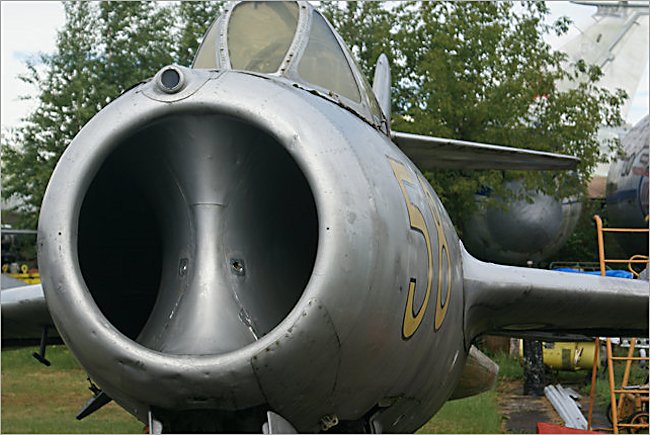MiG-15 UTI Soviet Jet Trainer
The Mikoyan-Gurevich MiG-15 UTI Fagot Soviet Jet fighter verse North American Aviation Inc F86 Saber dogfights dominated the Korean Air War. NATO maintained its habit of assigning Soviet fighters with F based names and bombers with B names. The two jet fighters were similar in many ways, but the MIG-15 did have a higher ceiling, was faster, higher rate of climb and had a tighter turning radius at low and medium speeds than the F-86 Sabre. The Mikoyan-Gurevich MIG-15s Fagot's bad points were its low rate of roll, stability problems at high altitude and control problems at high speed
These faults were used by the better trained American Pilots when developing dog fighting tactics. Many of the Allied pilots had World War Two experience where as apart from the Russian Advisors there were very few pilots on the North Korean side who had the same experience. Most MiG-15 pilots flying against the United States F-80s, F-84s and F-86s up until July 1951 were Soviet Pilots. They were then joined by communist Chinese pilots followed somewhat later by North Korean pilots.

Photograph taken at the Russian Aircraft Museum next to Riga International Airport Latvia
As Soviet MiG-15 pilots started to be withdrawn USAF F-86 Sabre pilots obtained higher kill ratios as the new Chinese and North Korean pilots were not as skilled as their Russian communist comrades. G suits were used by F-86 Sabre pilots while the MIG-15 pilots were not issued with them.
The only reason the Russians had such an advanced jet aircraft and able to shoot down so many NATO aircraft was a silly mistake by the British Government. The MIG-15's engine were a British design. It was a Russian copy of the Rolls Royce 'Nene' engine, of which 6 examples had been given to the Russians by the British socialist Prime Minister Clement Attlee in 1946.

Photograph taken at the Russian Aircraft Museum next to Riga International Airport Latvia
A variety of MiG-15 variants were built, but the most common was the MiG-15UTI two-seat trainer (NATO reporting code name was Midget for the training varient). Because Mikoyan-Gurevich never mass-produced the transition training versions of the later MiG-17 or MiG-19, the 'Midget' remained the sole Warsaw Pact advanced jet trainer well into the 1970s, the primary training role being fulfilled (save for Poland, who used their indigenous TS-11 Iskra jets) exclusively by Czechoslovak Aero L-29 Delfin (Maya) and the L-39 Albatros jets. While China produced two-seat trainer versions of the later MiG-17 and MiG-19, the Soviets felt that the MiG-15UTI was sufficient for their needs and did not produce their own trainer versions of those aircraft.

Photograph taken at the Russian Aircraft Museum next to Riga International Airport Latvia
The Mikoyan-Gurevich MiG-15 jet fighter had a maximum speed of 1,075 km/h (668 mph) with a cruise speed of 840 km/h (520 mph). It had a range of 1,200 km, 1,975 km with external tanks (745 miles / 1,225 miles). The Mig15's service ceiling was 15,500 m (50,850 ft). Its armament included two NR-23 23mm cannons in lower left fuselage (80 rounds per gun, 160 rounds total), one Nudelman N-37 37 mm cannon in lower right fuselage (40 rounds total), two 100 kg (220 lb) bombs, drop tanks, or unguided rockets on 2 underwing hardpoints.